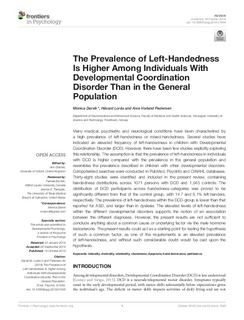| dc.contributor.author | Darvik, Monica | |
| dc.contributor.author | Lorås, Håvard Wuttudal | |
| dc.contributor.author | Pedersen, Arve Vorland | |
| dc.date.accessioned | 2019-05-03T06:22:50Z | |
| dc.date.available | 2019-05-03T06:22:50Z | |
| dc.date.created | 2018-10-16T13:07:02Z | |
| dc.date.issued | 2018 | |
| dc.identifier.citation | Frontiers in Psychology. 2018, 9 1-11. | nb_NO |
| dc.identifier.issn | 1664-1078 | |
| dc.identifier.uri | http://hdl.handle.net/11250/2596377 | |
| dc.description.abstract | Many medical, psychiatric and neurological conditions have been characterized by a high prevalence of left-handedness or mixed-handedness. Several studies have indicated an elevated frequency of left-handedness in children with Developmental Coordination Disorder (DCD). However, there have been few studies explicitly exploring this relationship. The assumption is that the prevalence of left-handedness in individuals with DCD is higher compared with the prevalence in the general population and resembles the prevalence described in children with other developmental disorders. Computerized searches were conducted in PubMed, PsycInfo and CINAHL databases. Thirty-eight studies were identified and included in the present review, containing handedness distributions across 1071 persons with DCD and 1,045 controls. The distribution of DCD participants across handedness-categories was proved to be significantly different from that of the control group, with 14.7 and 8.1% left-handers, respectively. The prevalence of left-handedness within the DCD-group is lower than that reported for ASD, and larger than in dyslexia. The elevated levels of left-handedness within the different developmental disorders supports the notion of an association between the different diagnoses. However, the present results are not sufficient to conclude anything about a common cause or underlying factor via the male hormone testosterone. The present results could act as a starting point for testing the hypothesis of such a common factor, as one of the requirements is an elevated prevalence of left-handedness, and without such considerable doubt would be cast upon the hypothesis. | nb_NO |
| dc.language.iso | eng | nb_NO |
| dc.publisher | Frontiers Media | nb_NO |
| dc.rights | Navngivelse 4.0 Internasjonal | * |
| dc.rights.uri | http://creativecommons.org/licenses/by/4.0/deed.no | * |
| dc.title | The prevalence of left-handedness is higher among individuals with developmental coordination disorder than in the general population | nb_NO |
| dc.type | Journal article | nb_NO |
| dc.type | Peer reviewed | nb_NO |
| dc.description.version | publishedVersion | nb_NO |
| dc.source.pagenumber | 1-11 | nb_NO |
| dc.source.volume | 9 | nb_NO |
| dc.source.journal | Frontiers in Psychology | nb_NO |
| dc.identifier.doi | 10.3389/fpsyg.2018.01948 | |
| dc.identifier.cristin | 1620783 | |
| dc.description.localcode | Copyright © 2018 Darvik, Lorås and Pedersen. This is an open-access article distributed under the terms of the Creative Commons Attribution License (CC BY). The use, distribution or reproduction in other forums is permitted, provided the original author(s) and the copyright owner(s) are credited and that the original publication in this journal is cited, in accordance with accepted academic practice. No use, distribution or reproduction is permitted which does not comply with these terms. | nb_NO |
| cristin.unitcode | 194,65,30,0 | |
| cristin.unitname | Institutt for nevromedisin og bevegelsesvitenskap | |
| cristin.ispublished | true | |
| cristin.fulltext | original | |
| cristin.qualitycode | 2 | |

